#canadian arctic region
Text
#WELP#i mean it was the inevitable conclusion#but the deal is now inked#canada#canadian politics#f 35a lightning ii#“concerns about it performing in arctic regions” given I live in a city where our new train is a lemon especially in winter....#this resonates
0 notes
Text
the smoke from the wildfires in canada are crossing the atlantic and is now bringing a haze to the nordic countries
it's said that the soot from the smoke will deposit onto the snow and ice of the arctic which will in turn increase local warming (i.e worst wildfires, ice sheets melting, oceans warming and rising, stronger tropical cyclones, etc. etc.)
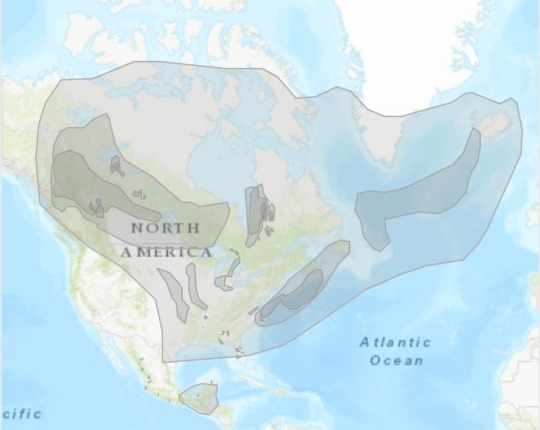
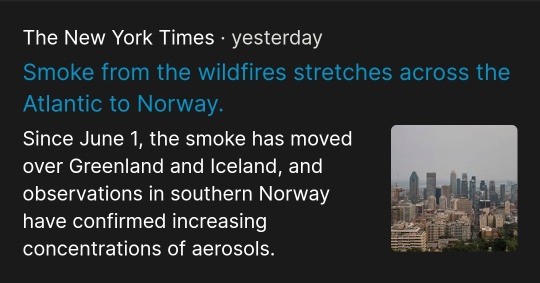
From the NY Times (and other sources):
Ways to Help
The Canadian Red Cross: Every $1 donated to the Canadian Red Cross will become $3 to support those affected by wildfires. The funds will be directed to people living in Nova Scotia and other Atlantic provinces, some of the hardest hit areas, for immediate and ongoing relief and recovery efforts as well as community preparedness initiatives.
United Way: The Canadian federal government joined the government of the Northwest Territories in a similar matching program to support disaster relief and recovery efforts. The funds will be used to support nonprofit community groups who are helping local residents.
Donate a Mask: This volunteer-run charity ships free N95-equivalent masks to anyone in Canada who requests them, with priority to Canadians who cannot afford or do not have access to high-quality masks.
Firefighters Without Borders: This Ontario-based nonprofit donates equipment and training to communities across Canada and in other countries.
Odawa Native Friendship Centre: The Odawa NFC is a nonprofit organization serving the Indigenous community in the Ottawa-Carleton region and is currently collecting donations for First Nation evacuees (with “wildfire evacuees” as the donation type). On Facebook, the NFC noted that it can no longer accept clothing donations.
Canadian Interagency Forest Fire Centre (CIFFC): Live map of the fires. Updated daily.
APTN National News: Newspaper on the Indigenous Peoples of Canada. Can be used to understand how the climate is affecting the Inuit, Métis, and First Nations.
#canadian politics#canadian wildfires#canada#wildfire#wildfires#fire#climate change#environmentalism#mutual aid#mutual assistance#weather#meteorology#academia#studyblr
2K notes
·
View notes
Text
╭─────────────────── · · · · ♡ ───

╰─────────────────── · · · · ♡ ───
OCTONAUTS HEADCANONS + canon sprinkles
-ˋˏ ༻ ♡ ༺ ˎˊ-
CAPTAIN BARNACLES

— mid 30s or late 30s
— has been the Captain for 15–20 years; became Captain around the age of 20
— the tallest and strongest of the crew
— Canadian; seen from his room decoration where he had a banner called ‘MV Manitoba’ and his sister Bianca and her cubs—Orson & Ursa—live in Northern Canada (Arctic region)
— sometime after he graduated Polar Scouts he got a position on a ship— MV Manitoba; it is very likely that he met Tweak on this ship
— adding: the ship, probably, crashed during a big storm, and he moved back to the Arctic to train Tracker; if you look closely, Barnacles tends to become more tense during storms
— blames himself if one of his crew gets hurt
— autistic? probably
— polar bears shed their fur, so he sheds a LOT since his location changes all the time (headcanons here)
— very fluffy when his winter coat is fully grown, looks smaller when it’s fully shed
— adding: everyone on the Octopod has had that first summer when they are just in shock because the Captain suddenly looks so much smaller, and especially Peso freaked out
— the crew’s Dad™; everyone on the crew (expect maybe prof. Inkling) sees him as a father figure (especially Peso and Dashi)
— everyone but Inkling has slipped up and called him dad by accident at least once
— sees Natquik as his father figure (gave him a father’s day present as a cub once and they both cried)
— speaking of father’s day, the crew gives him a father’s day present every year (as a thank you, of course, nothing else) (he cries when he gets into his room, he loves his kids crew)
— too self-sacrificing for his own good; has given Peso a heart attack multiple times /hj
— scolds Kwazii for being reckless but does pretty stupid sh*t himself (see above)
— likes mint chocolate and mint-flavored things in general
— loves hot chocolate
— favorite flavor of kelp cake is chocolate
— so basically this man likes chocolate a lot (just like me fr)
— secretly a huge cuddle bug; when he visits his family in the Arctic and stays the night or two, he cuddles with Bianca and the cubs
— sleeps with a picture of him and Bianca under his pillow to not feel too homesick
— keeps a picture of the crew on him at all times, usually on his Octo-Compass
— would be the best father the ocean has ever seen and no I don’t take criticism
— literally has Dad Lore™; when he’s old, he might just drop some random facts or some stuff that happened that no one knew very casually and shock everyone
— this is canon, but I’m putting it anyway: claustrophobic and has PTSD
— in need of therapy (canon) and a break (canon²)
— mr. “hurt? no I’m fine, just doing my job!”
— basically it’s like “are you okay?” “I’m fine” *as he’s literally bleeding out*
— book smart but also street smart, yet also a little stupid (affectionate) at the same time
— understands most modern lingo but loves using it incorrectly just to mess with the rest of the crew (Inkling joins him sometimes) .
— adding: jokingly said “me-me” once in a super serious tone and earned the wrath of the crew (except Inkling who didn’t see the problem and it caused a whole argument)
— LOVES cold and snow and ice; that being said, he deals with a hot climate, but not for very long
— great immune system, but if he gets sick, boy he is SICK (Peso will literally have to tie him to the bed because he refuses to rest)
— is severely injured a couple of times a year, typically due to selflessness
— overall very reluctant to seek medical help and attention because he’s fine what do you mean
— polar bears are the most carnivorous of the bear family, so he eats a lot of meat
— very careful when helping small creatures because he’s huge and doesn’t want to hurt them; constantly worried he’d crush them .
— stands with his claws facing backwards and kneels down when talking to creatures smaller than him (both canon) to make them feel less intimidated, which he learned in the Polar Scouts (Tracker does it too)
— doesn’t know how to handle being flirted with (if he even realizes it, which he probably doesn’t)
— Peso and him are Cold Weather Buddies™
— Tunip is his Emotional Support Vegimal™ (either doesn’t know or realize)
— has a great singing voice and definitely sings in the shower
— has the deepest voice of the crew and in the morning it sometimes scares them due to how deep it is all of a sudden (Kwazii once joked Barnacles was being possessed)
— gives the BEST (bear) hugs
— maybe on the ace spectrum (no I’m definitely not projocting what are you talking about /hj)
— doesn’t really share his backstory, & only shares some of his more fond memories of the Polar Scouts
— Natquik is the only one who has seen him lose his temper / have a full-on breakdown
— loves playing the accordion (canon); though unfortunately, has trouble playing it well (he’s doing his best—also am I the only one who likes it??)
— his other (canon) hobbies include writing in his Captain’s log, exercising, making shadow puppet shows, singing sea shanties, dancing to music with the Vegimals, building models and drawing
— an oceanographer and a map finder (canon)
— his Octo-Compass, while a small device, is multi-functional; it was a gift from Tweak
— has many embarrassing stories from his youth that he WON’T share and he forbids Bianca from telling anyone from his crew
— chubby; when someone’s truly muscular, they are going to be a bit chubby, and with the density of muscle mass Barnacles must have due to his level of strength, he’s going to obviously be a bit more chubby
— big as in “Big Beefy Polar Bear”
— has GIANT fluffy paws; sometimes, when the crew compares paw sizes with him they are just... smol (& also generally compared to him)
— listens to The Wellerman a lot
— possibly the highest pain tolerance out of the crew and Octo-Agents
— knows Russian because of Natquik
— a part of his brain is always awake, causing him to be alert at all times (kinda reminds me of Mad-Eye Moody’s CONSTANT VIGILANCE)
— canon, but sees Octopod as ‘home’ 🩵
-ˋˏ ༻ ♡ ༺ ˎˊ-
KWAZII

— late 20s (he’s referred to as Kwazii Kitten)
— sleeps with a slightly worn teddy bear that has an eye patch (it was a gift from Calico Jack)
— has ADHD and Dyslexia
— also has heterochromia, a green eye and a brown eye, and the green eye is covered
— cannot stay still, literally has to move or he feels like he’ll explode right then and there
— the most acrobatic of the crew
— probably gay or pan
— FTM trans 🏳⚧
— adding: bonds with Tweak and Tominnow
— likes dressing up in costumes, especially dresses because f*ck gender roles
— half-Caribbean (dad’s side)
— was abandoned / disowned by his family because he wasn’t the “traditional” kind of pirate and was instead kind and such
— like already said, is not like the rest of his family ; but does look up to his grandfather, Calico Jack, a role model of his
— sometimes gets sad that some creatures get scared of him since he’s a pirate but it’s part of his identity and he doesn’t want to throw it away either
— one of Barnacles’ closest friends and would die for him (as if Barnacles would let it happen, but hypothetically speaking)
— sees Tweak as a sister figure and will go to her if he needs a quick pat on the back (here)
— sees Peso as a brother and teases him but if someone so much as looks at Peso wrong? he’s getting out his sword
— even if he doesn’t always listen when given orders, he looks up to Barnacles (both figuratively and literally) and has a lot of respect for him, just like the entire crew
— unlike Barnacles, Kwazii’s like: “are you okay?” “no I’m literally f*cking dying” *as he’s perfectly fine*
— is in the Sick Bay a lot; usually because he did something stupid/reckless and got hurt
— great immune system but still manages to get sick easier than, for example, Barnacles
— an orange cat (iykyk)
— very cat-like and out of the crew he acts most like the animal he is
— he loafs; once in the HQ on top of Dashi’s workstation and she just pushed him off (he hissed at her, in a playful manner of course)
— has a bad habit of chewing on stuff and accidentally leaving his stuff everywhere
— sheds a bit too and used to let Barnacles borrow his shedding brush
— adding: eventually just got him his own as a gift because lord knows the Captain needs it (it’s definitely one of the ones that release the brushed fur in neat circles) .
— used to curse but due to Barnacles’ wishes he came up with variations (‘shiver me whiskers!’)
— starts singing sea shanties out of nowhere; pretty good singer, actually
— has a music box that plays sea shanties
— writes the pirate stories he has heard down into one, big book of pirate tales
— likes telling stories and sometimes holds a story-telling night with the Vegimals
— adding: sometimes Paani joins them
— speaking of Paani, they sometimes bake together; it’s... a bit of a disaster, though
— quotes Vines on a daily basis (with Dashi finishing some of them for him)
— has a gold earring with the Octopod engraved on the back (see here)
— loves storms, exploring, general excitement and swashbuckling
— watches Pirates of the Caribbean movies
— one of the first to know about Barnacles’ claustrophobia
— the prank master; every april’s fools day is just everyone mostly trying to avoid Kwazii
— adding: the only one who manages to succesfully prank Kwazii is Tweak
— hot-blooded and considered to be one of the bravest of the Octonauts, but does have arachnophobia and has a soft heart for cute small animals, especially the babies
— hates the cold and thinks Barnacles and Peso must have lost their minds whenever they’re enjoying the cold weather; it’s the Caribbean side of him talking
— speaks with a Cockney accent and a typical sea ferrying dialect
— adding: was slightly insecure about being a pirate, and so everyone started also saying “aye!” instead of yes to make him feel better (it worked) and then it just ✨stuck✨
— has retractable claws, sharp cat teeth and paw beans coloured yellow like his muzzle
— knows how to pick locks with his claws
— has scars! likes to call them battle scars; basically it’s like *gets a wound* “sick, a new scar :D”
— definitely has some sort of trauma
— plays the recorder, drums and bass guitar
— hobbies include collecting treasures in his room, playing with / chewing on yarn, taking catnaps, watering his catnip plant, practicing cat-fu, lifting weights, & knitting / crocheting scarves (sometimes with the Vegimals)
— has a hair-ball collection (which he hides)
— knows how to find secret passageways and how to identify them
-ˋˏ ༻ ♡ ༺ ˎˊ-
PESO

— early 30s (like, c’mon, he’s a doctor and went to medical school, be fr)
— maybe more like a paramedic; he gives medical care in an emergency
— also the newest recruit on the Octopod
— shortest, if we don’t count the Vegimals
— Chilean (a part of Antarctica belongs to Chile) .
— knows different languages other than English, like Spanish and a bit of Latin
— as already said, him and Barnacles are Cold Weather Buddies™
— loves cold and snow and ice
— cannot handle heat for a long time
— from a large family of penguins; he likes having that kind of family because they all look out for each other
— adding: though it’s possible that growing up in such a big family / around many other penguins he got compared to them quite a bit and/or never fully got to shine
— sometimes mixes up names and gets everyone confused, himself included
— has always tried to be a good example for his younger brother, Pinto
— has a little round stone that he hangs on to ‘just in case’ (some penguins give round stones to the other penguin that they want to mate with—adorable)
— speaking of rocks, he collects them religiously
— has anxiety, but manages it just fine
— was very dependent on others and always compared himself to his friends / the rest of the crew (mainly Barnacles and Kwazii) .
— adding: has become more confident in his skills and himself overall over time
— best friends with Shellington and Kwazii
— idolizes Barnacles, but also looks up to Kwazii because of his braveness (even if it’s mostly Kwazii being reckless than anything else)
— Barnacles is like a father figure to him .
— gets really worried when one of the crew (*cough* Barnacles, Kwazii, Shellington *cough*) end up in the Sick Bay
— very shy and gets easily scared by Kwazii’s spooky stories but is brave when needed
— adding: bravery isn’t not being scared, it’s doing what you need to while scared—which is exactly what Peso does (“courage isn’t the absence of fear, but rather acting in spite of it” and Peso is the epitome of that)
— loves playing the xylophone & is good at it
— great listener and an awesome comforter; also the crew’s unofficial therapist™
— definitely a good cuddler, I mean come on, look at him! he looks so soft
— would (aggressively) support you if you came out to him
— preens sometimes, just sort of fixing up his feathers and some (Kwazii) of the crew are like ‘why are you stabbing yourself??’
— adding: Shellington explains it every time and Peso tries not to laugh
— super fast swimmer (“I’m fast as f boiiii—”)
— flaps when he’s happy and sometimes does a little dance too
— often studies when he’s not busy; sometimes with Shellington
-ˋˏ ༻ ♡ ༺ ˎˊ-
SHELLINGTON
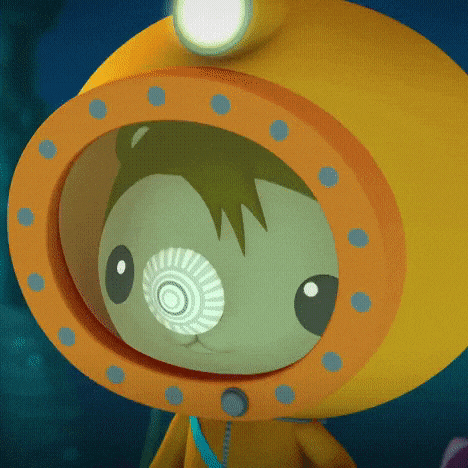
— early 30s (younger than Pearl), older than Peso
— also collects rocks (though not as much as Peso)
— is not only allergic to sea urchins (which is, of course, canon) but also certain mussels
— autistic; one of his stims (besides “jumpin’ jellyfish!”) is shaking his hands excitedly
— Scottish (yes I know otters don’t live there but idc, he and Pearl were born there end of discussion)
— probably pan
— awkward and clumsy but very sweet
— is in the Sick Bay a lot; usually because he accidentally hurt himself in the Lab
— owns a pop-up bed in his laboratory, which he barely uses
— adding: messed up sleep schedule pt.1
— sometimes sleeps with the Vegimals like stuffed animals (they don’t mind)
— has a little plushie he holds hands with at night just like otters hold hands in real life
— sleeps with a picture of him and Pearl under his pillow
— facetimes Pearl and Periwinkle every week or Pearl facetimes him
— gives Tweak anxiety when he’s driving a Gup because as we all know, he can’t drive
— fascinated by the way Kwazii drives Gups and is determinded to learn how to drive
— besides marine biology, he also has an interest in linguistics which would be how he learned to understand Vegimalese and other creatures even when they’re like muffling or have their mouths full (see this post)
— knows Latin (bro’s a scientist, c’mon)
— when he finally learned Vegimalese, he cried and almost squished the Vegimals
— has a preference for kelp cakes and clam sandwiches
— likes to top his kelp cakes with hot sauce; however, too much upsets his stomach
— adding: the rest of the crew looks at him like he’s a madman everytime he does that, but then brush it off as “he’s a scientist, he knows what he’s doing” he indeed does not
— favourite kelp cake is watermelon
— some of his talents include playing the harp and the piano, golfing, drawing, being humorous, crashing the Gups (it is a talent at this point) and identifying different creatures
— his hobbies include drinking tea, polishing his clam collection, playing Table Tennis and Miniature Golf, discovering / studying new creatures and journaling his studies
— Tunip calls him “Shellydo” and sometimes Tunip and the other Vegimals call him dad
— gets both a father’s day present AND a mother’s day present every year from the Vegimals; he cries every time
— when the Vegimals were still learning how to cook Shellington was the one who taught them, and also ate everything the Vegimals made even if it tasted absolutely terrible .
— best friends with Peso and Dashi
— watches nature documentaries with Dashi and comments on the sea creatures
— often studies with Peso about different creatures and how to help them
-ˋˏ ༻ ♡ ༺ ˎˊ-
DASHI
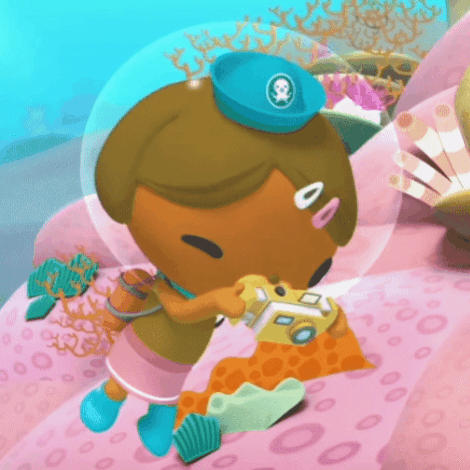
— mid 20s to late 20s
— Gen Z and uses that to her advantage; enjoys messing with Barnacles (“hey captain, yeet!” “what? what’s a ye—” *almost gets bonked by something Dashi threw if it wasn’t for his reflexes*)
— adding: has somehow taught some things to Shellington, and now whenever she wants to ask him something, she just goes “science side of tumblr [insert thing]” and he answers the question like it’s a tumblr post
— quotes Vines almost on a daily basis (with usually Kwazii joining her)
— IT officer, photographer, meteorologist
— technically the Captain of the Octo-Ray (?) (atm watching what I can of Above and Beyond so idk)
— Australian
— definitely not straight, probably bi
— when she gets excited her tail wags really fast and she gets embarrassed by it
— writes a journal, though currently it’s more like a scrapbook with a hundred pictures and stickers and drawings (and some comments from the rest of the crew <3)
— best friends with Shellington and Tweak
— has sleepovers and Girls’ Night Outs with Tweak every week
— usually tags with Shellington on missions because while he has the knowledge on the creatures, she takes pictures for them both; also because she gets along with him well
— was taught about cave diving by Ryla
— loves surfing because it reminds her of Australia and the time she lived there
— embraces her femininity with pride and enjoys traditionally feminine things (go girl!)
— sees Captain Barnacles as a father figure and looks up to him a lot (basically his daughter)
— makes photo albums for the others on birthdays or if they’re sad; the photo albums usually consist of all their favourite moments and adventures (she has a few pre-made albums for each Octonaut in case she’s too busy to make one) .
— did and still does her best to be a good role model to Koshi (older sister responsibilities)
— loves reading
— LOVES Barbie and has movie nights / marathons with Koshi or Tweak
— adding: cried when watching the Barbie movie and was never the same after
— if she sees a potentially great place to get a photo of something, she will become worse than Kwazii in recklessness to GET THERE to take the photo, no matter where or what it is and it stresses the f out of Barnacles
— can sometimes be almost as daredevilish as Kwazii (see above)
— once, when she was having a bad fight with Tweak, she accidentally barked, which caused them both to freeze and then Tweak to burst out laughing, and they forgot about the fight entirely; they still laugh about it
— knows a lot of gossip but doesn’t spill anything if she knows she shouldn’t
— has a great fashion sense
— when she was a little girl, she wanted to be a mermaid (same) and she even bought one of those mermaid tails once but lost it
-ˋˏ ༻ ♡ ༺ ˎˊ-
TWEAK
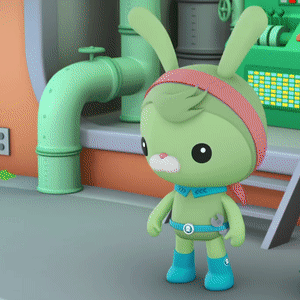
— late 20s to early 30s
— one of Barnacles’ oldest friends and was the first recruited Octonaut
— engineer and literally does not stop designing and building things
— MTF trans 🏳⚧
— either lesbian or aroace
— messed up sleep schedule pt.2
— when she’s pissed off or frustrated, she’ll tap her foot really quickly and repeatedly
— has a Southern accent
— best friends with Dashi and Sandy the Leatherback Sea Turtle
— sees Kwazii as a brother figure
— enjoys being a lil sh*t towards Kwazii; it’s a hobby at this point (he does it to her too)
— hobbies include playing badminton and video games (“Turtle Tactic”), reading video game manuals / guides, building things and designing new things to build
— Minecraft player and a redstone engineer
— grew up in the Everglades in Florida with her father Ranger Marsh, and as a result of that, she’s a tomboy (also bc she’s trans)
— growing up in the Everglades Tweak started building gadgets and gizmos, and then eventually joined the Manitoba crew where she met Barnacles
— adding: after the crashing of MV Manitoba she returned to Everglades, before Barnacles recruited her to the Octonauts crew
— can play the banjo; learnt from her dad
— favourite kelp cake is carrot (obviously)
— eats carrots to keep her teeth healthy (and out of habit she’s had since her childhood)
— is somewhat camera shy
— filled with anxiety when Shellington is behind the wheel of any of the Gups
— also filled with anxiety when Kwazii drives
— doesn’t exactly like it that those two keep crashing the Gups so she has to fix them all over again but at least she doesn’t get bored
— Dashi once showed her the Florida Man™ memes and she couldn’t stop laughing for five minutes; she sent one to her dad
— owns so many Lego sets
-ˋˏ ༻ ♡ ༺ ˎˊ-
PROFESSOR INKLING

— around mid 60s, idk he’s just pretty old
— Uncle Iroh™ of the crew; the Octonauts frequently go to him for advice (and tea)
— knows his library like the back of his, uh, tentacles?
— if he reads a book about how to do something, he can do it
— adding: can memorize basically anything that’s in a book
— founded the Octonauts and when he met Barnacles, Inkling asked him to become the Captain; Barnacles of course accepted
— doesn’t actually have a bed because he refuses to sleep on anything but his chair.
— canon, but a good, old friend of Min’s
— kind of like a grandfather figure to Kwazii
-ˋˏ ༻ ♡ ༺ ˎˊ-
TUNIP AND THE VEGIMALS
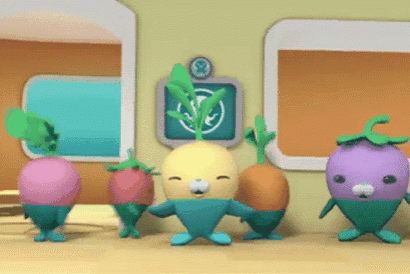
— they’re aliens. periodt.
— at first Shellington tried to let them back into the ocean but no matter what they kept on coming back so the crew just adopted them let them stay (based on this post)
— they (especially Barrot) used to be scared of Tweak because of her carrot-eating
— they have a song and a choreography for almost every situation (no one knows how)
— sometimes bury themselves in the ground of the garden pod for fun or sometimes even to sleep ; have scared various crew members half to death many times by doing this .
— are actually quite smart due to them growing up with the Octonauts aka the biggest nerds in the ocean™
— the other Vegimals turn to Tunip when they need any kind of support or advice
— Tunip, on the other hand, turns to either Shellington or Barnacles when in need
— Tunip also mimics Barnacles and really looks up to him (both figuratively and literally)
— was already said, but Tunip is Barnacles’ Emotional Support Vegimal™
— Shellington’s adopted kids (canon)
— Tominnow is MTF trans 🏳⚧ and looks up to Kwazii (and sometimes even mimics him)
— the Octopod is their Habitat™
-ˋˏ ༻ ♡ ༺ ˎˊ-
THE OCTOPOD
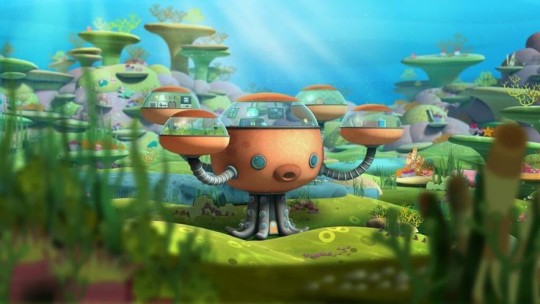
— everything is waterproof. everything
— the screens in the bedroom pods can be customized with different apps + functions; everyone has completely unique settings, & the ones in the hallway work the same, but have preset settings (headcanons here)
— any screen can be used to communicate, play games or music, as a camera, a mirror and a TV; and also sound the Octoalert
— the metal cover thingies that cover the glass of the pods during a storm work like convertible roofs, and anyone in one of the bedroom pods can put them down only on their side if they need / want privacy
— there are similar metal cover things that Tweak can pull down over her loft room or her workshop if she needs to
— the glass is indestructible and the entire ship weighs like a million tons
— Barnacles’ and Peso’s rooms are colder than the rest of the crew’s (for a homey feel)
— the steering wheel being a traditional wooden wheel was a present for Barnacles’ first birthday as Captain; from prof. Inkling
— has its own unofficial time zone that the crew follows just because of how much they move around and thus switch time zones .
-ˋˏ ༻ ♡ ༺ ˎˊ-
NOTE : WILL BE UPDATED WHEN I FIND / COME UP WITH NEW STUFF !
#octonauts#octonauts headcanons#captain barnacles#kwazii#peso#shellington#dashi#tweak#professor inkling#octonauts tunip#octonauts vegimals#vegimals
58 notes
·
View notes
Text


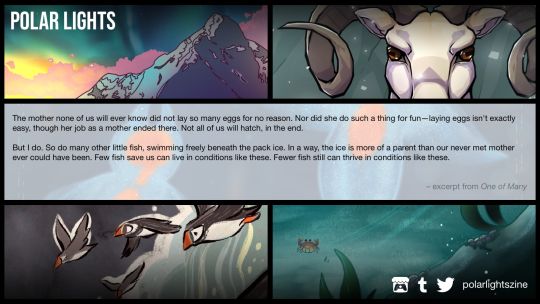
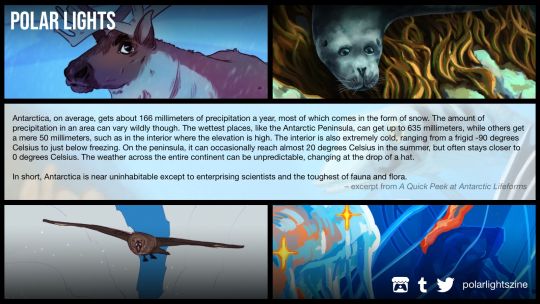
❄️ POLAR LIGHTS Now Live!
Polar Lights is a charity anthology featuring original work from 26 creators in a collection of 26 full colour illustrations, 3 written pieces, and a mobile wallpaper pack.
All proceeds benefit the Arctic Research Foundation (ARF), a private, non-profit organization creating new scientific infrastructure for the Canadian Arctic and sharing perspectives on the most critical and understudied regions of the North.
Grab a digital copy of the zine for as little as $2! 💙
Shares greatly appreciated.
237 notes
·
View notes
Text
So Minecraft has new wolves!!
I am very happy about this, but it does make me curious what species each variation is based off of! You too? Awesome!
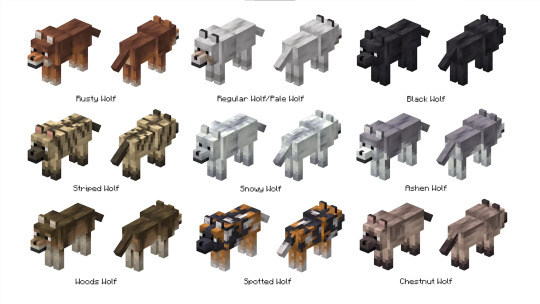
Rusty Wolf = Dhole



Seeing a little red jungle wolf took me right back to reading The Jungle Book as a kid, so I pretty much instantly decided they were dholes! A.k.a. Asian wild dogs or red dogs. They're an endangered canid native to Central, South, East and Southeast Asia, and they live in large clans ranging from 12-40 members.
Pale (Original) Wolf & Black Wolf = Grey Wolves
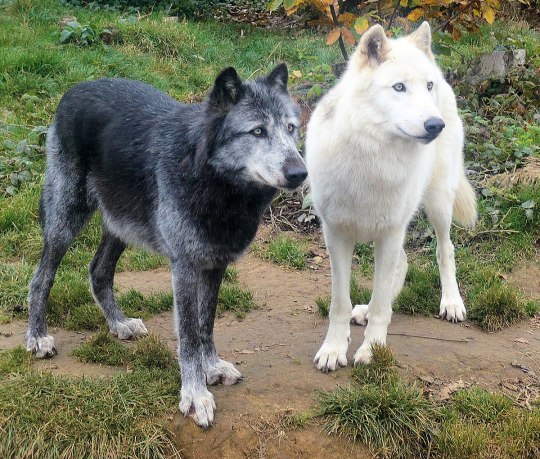
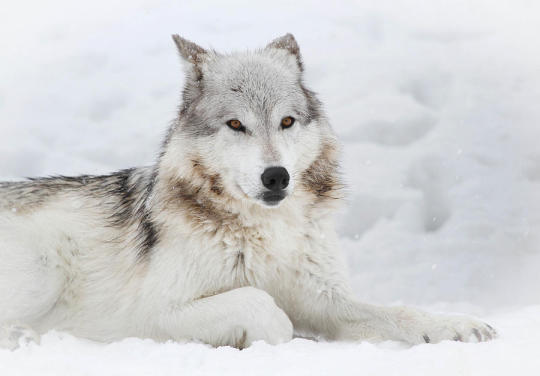
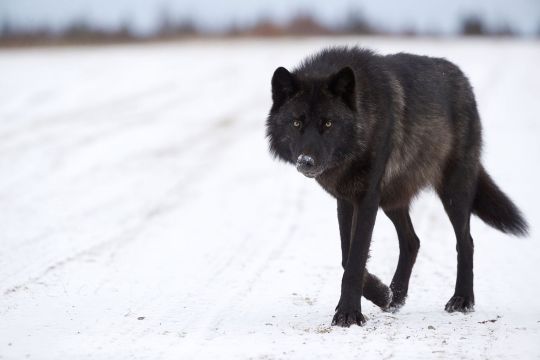
Our familiar friends have probably always been North American grey wolves, just pales ones! Despite their name, this iconic member of the canid family has an incredible amount of variation, and different subspecies of them are scattered all over North America.
Striped Wolf = Aardwolf
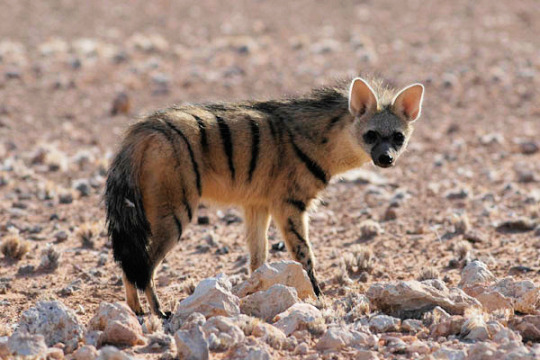
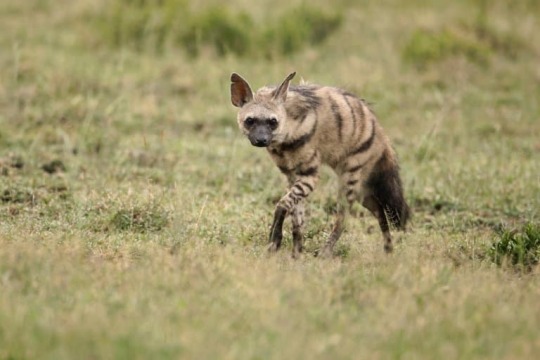
Okay, this is interesting, because they are definitely aardwolves! However, despite their names, aardwolves are actually the tiniest member of the hyaenidae family! Native to East and Southern Africa, they are exclusively insectivores and are known for following aardvarks to use their vacated burrows and foraging grounds. I think it's fascinating that a hyena was chosen for the wolf skins!
Snowy Wolf = Arctic Wolf

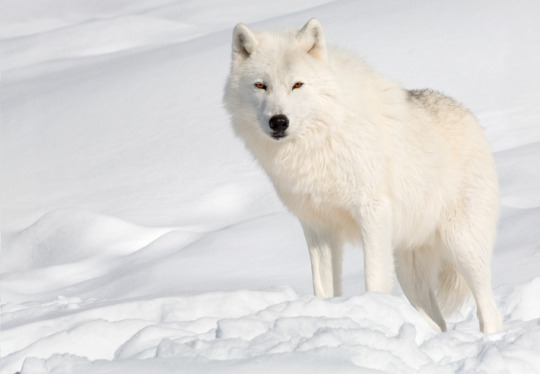
One of the many subspecies of gray wolves, arctic wolves are native to the Canadian Arctic and Alaska. Thanks to their territory being generally undesirable to humans, they are the only subspecies that can found across the entirety of their original range. Arctic wolves seem the most logical choice for snowy wolves, through there are several other pale-coated northern subspecies they could technically be.
Ashen Wolf = Northwestern Wolf


Speaking of northern subspecies, let's have some fun with the ashen variant. I'm pinning them as the Northwestern wolf, a.k.a. the Mackenzie Valley wolf! Native to, well, the northwestern part of Canada and Alaska, they are arguably the largest subspecies of wolf we know of. They match up pretty well with their Minecraft counterparts both in terms of habitat and possible coloration!
Woods Wolf = Eastern Wolf
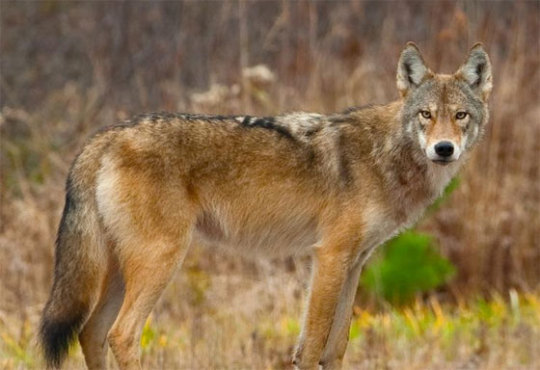
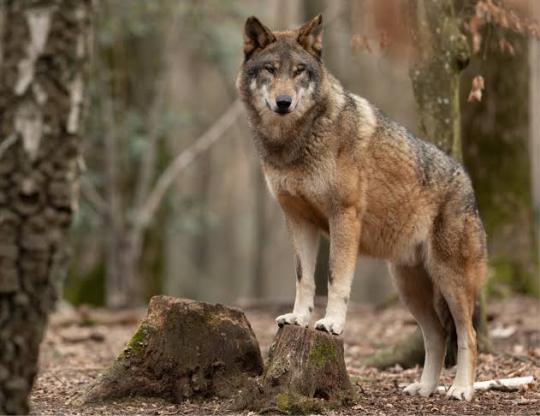
Ooo, okay, I went down a rabbit hole with this one! Eastern wolves, a.k.a Great Lakes wolves or Algonquin wolves, are native to the Great Lakes region of North America. They exist in an identification limbo, with no current ruling on whether they are a subspecies of grey wolf, red wolf, or their own unique branch that drifts closer to coyotes on the canid family tree. There is even some debate on whether the Great Lakes and Algonquin variants should be counted as the same subspecies, which I think is fascinating!
Spotted Wolf = African Wild Dog


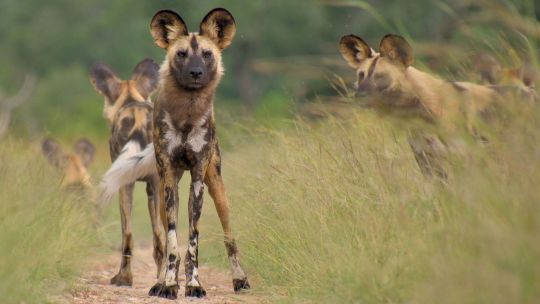
The more people who know these good bois exists, the happier I am. African wild dogs, a.k.a. painted dogs or Cape hunting dogs, are the largest wild canine in Africa. They live in packs of 5-30 members and are known their cooperative hunting tactics, using stamina to wear down prey. They're highly social animals, and you'll never find a lone dog.
Chestnut Wolf = Bat Eared Fox
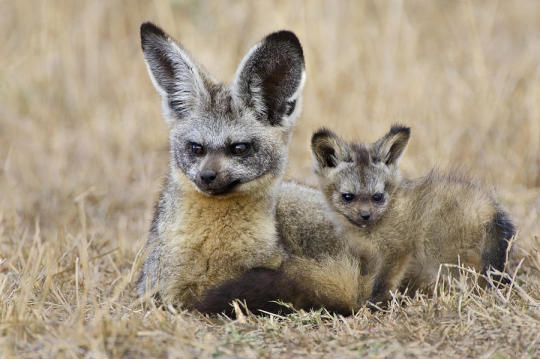
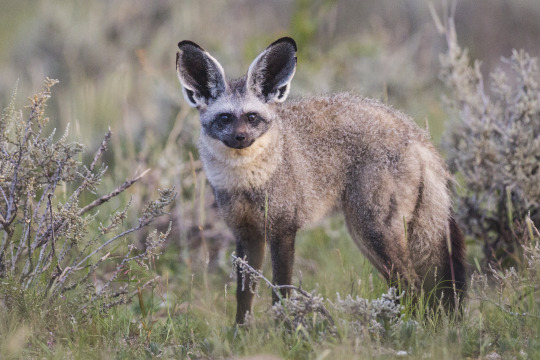
So, initially, I wrote off these guys cause I wasn't counting foxes, but I gave in. The chestnut wolves don't look like much of any existing canines, and nothing that lives in taiga forest. So, bat eared foxes are my best guess. They're small canids native to southern Africa, and are part of the subfamily Otocyoninae, which is a sister family to the families containing true foxes and racoon dogs.

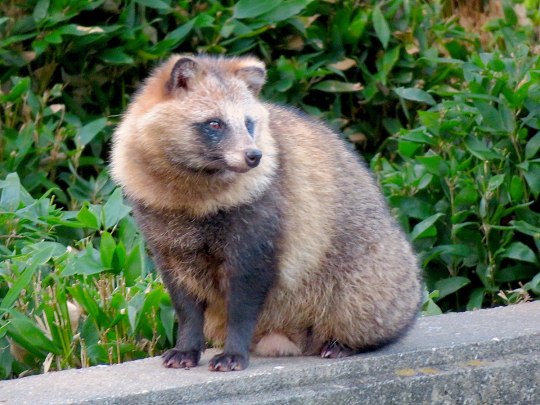
Speaking of raccoon dogs, they're my second best guess for the origin of the chestnut wolf. Their habitat makes slightly more sense, being from the forests of Japan and east Asia!
#i finally get to infodump on cool animals#also i learned A LOT researching for this!#minecraft#minecraft wolf#sharp has too many thoughts
19 notes
·
View notes
Text
If built, Donlin would be the largest open pit pure gold mine in the world within one of the world’s largest river deltas. The ecosystem it threatens is vitally important for fish, wildlife, food security, and the physical, cultural, spiritual, and mental wellbeing of the Alaska Native people who have lived here for thousands of years.
Industry and its boosters dream of the last frontier crisscrossed with massive mines, oil fields, pipelines, roads, and other infrastructure, but it’s not empty land. Tribes who have lived in this region from time immemorial say projects like Donlin conflict with traditional ways of life and the Tribes’ present existence. Other Alaskans and Americans from across the country feel deeply about protecting these lands and waters too, as demonstrated when they raised their voices against Pebble Mine in Bristol Bay, drilling in the Arctic Refuge, and ConocoPhillips’s Willow Project — all of which Earthjustice challenged in court.
Donlin, jointly owned by two Canadian mining giants, Novagold and Barrick Gold, is supported by the region’s for-profit Alaska Native corporations, who own the surface and subsurface rights to the mine, but not by most Tribes in the region. More than a dozen Tribes have passed formal resolutions opposing the project, and six Tribes and an Alaska nonprofit, represented by Earthjustice, are challenging the project on legal grounds. All told, litigants have brought four separate lawsuits opposing the mine in state and federal court, with different plaintiffs on each case.
#Alaska#Indigenous Americans#Kuskokwim River#Tuluksak#environmental racism#environmental issues#indigenous rights#indigenous peoples#Donlin gold mine
42 notes
·
View notes
Text
Summer sea ice in the Arctic could melt almost completely by the 2030s—roughly a decade earlier than projected—even if humans cut back drastically on greenhouse gas emissions, new research suggests.
“We are very quickly about to lose the Arctic summer sea-ice cover, basically independent of what we are doing,” Dirk Notz, a climate scientist at the University of Hamburg in Germany tells the New York Times’ Raymond Zhong. “We’ve been waiting too long now to do something about climate change to still protect the remaining ice.”
An ice-free summer, also called a “blue ocean event,” will happen when the sea ice drops below one million square kilometers (386,102 square miles), writes Jonathan Bamber, a professor of physical geography at the University of Bristol, in the Conversation. This equates to just 15 percent of the Arctic’s seasonal minimum ice cover of the late 1970s, per the Times.
Previous assessments using models have estimated an ice-free summer under high and intermediate emissions scenarios by 2050. But researchers noticed differences between what climate models predicted about what would happen to sea ice and what they've actually seen through observations, according to Bob Weber of the Canadian Press. "The models, on average, underestimate sea ice decline compared with observations," says Nathan Gillett, an environment and climate change Canada scientist, to Weber.
Now, in a new study published in Nature Communications, Notz, Gillett and their colleagues tweaked these models to more closely fit satellite data collected over the past 40 years. Using these modified models, the researchers projected ice changes under different possible levels of greenhouse gas emissions. Their paper suggests that regardless of emissions scenario, “we may experience an unprecedented ice-free Arctic climate in the next decade or two.” Under a high emissions scenario, the Arctic could see a sustained loss of sea ice from August until as late as October before the 2080s, lead author Seung-Ki Min, a climate scientist at Pohang University of Science and Technology in South Korea, tells CNN’s Rachel Ramirez.
While sea ice naturally shrinks in the summer and refreezes during the winter, summer ice coverage has steadily been declining over the past few decades because of climate change. And Arctic ice melting accelerates itself—as ice disappears, it exposes more of the dark blue ocean, which absorbs more heat and leads to more melting. This process, known as Arctic amplification, has led to the region warming nearly four times faster than the rest of the globe since 1979.
Sea ice decline could have catastrophic consequences that extend to the rest of the planet, including sea level rise and disruption to weather patterns and ecosystems. Animals like polar bears and seals that rely on Arctic ice to survive could be placed at risk.
“It’s already happening,” Mark C. Serreze, the director of the National Snow and Ice Data Center at the University of Colorado Boulder who was not involved with the new research, tells the Times. “And as the Arctic continues to lose its ice, those impacts will grow and grow and grow.”
#current events#climate change#global warming#environmentalism#ecology#meteorology#weather#ice#sea ice#arctic circle
47 notes
·
View notes
Text
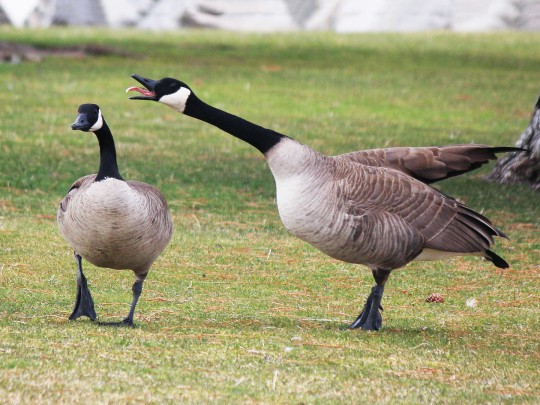
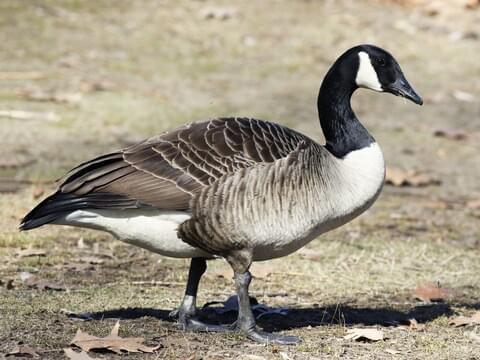
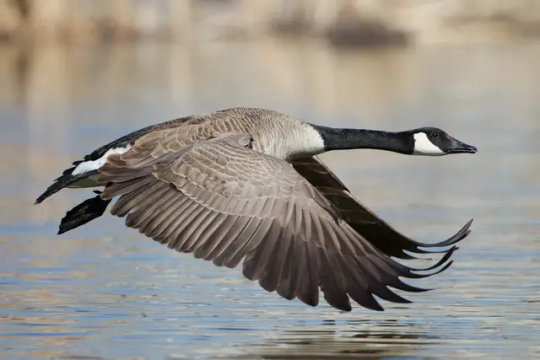



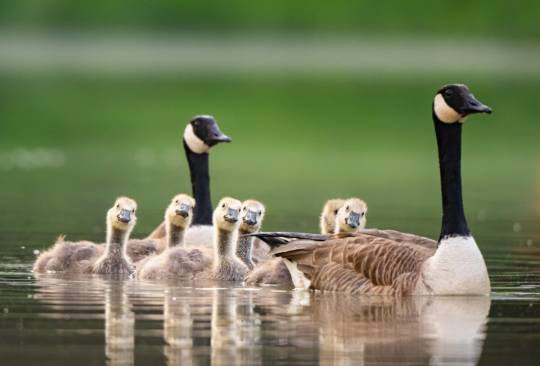

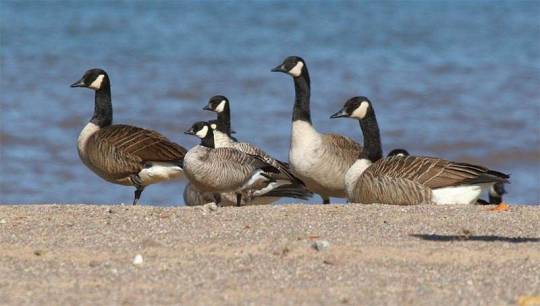


Branta Canadensis better known as the Canada goose, the burnt black goose, or the Canadian goose is a species of geese in the waterfowl family Anatidae is native to the arctic and temperate regions of North America, and has been introduced to France, England, Scotland, Wales, Ireland, Finland, Sweden, Denmark, New Zealand, Japan, Chile, Argentina, and the Falkland Islands. The Canadian goose is typically social species which lives in large flock which during migration may exceed 1,000 birds in number. They live in and around water sources such as lagoons, brackish marshes, estuaries, rivers, lakes, swamps, and ponds. Here they feed upon grasses, shrubs, fruit, flowers, seeds, beans, grains, and various aquatic plants such as sea weed. Canadian Geese are preyed upon by coyotes, wolves, bears, feral dogs, alligators, snapping turtles, wolverines, large owls, eagles, goshawks, peregrine falcons, and gryfalcons. Reaching around 30 to 43inches (75 to 110cms) in length, 5 to 24lbs (2.4 to 10.9kgs) in weight, with a 50 to 88 inch (127 to 225cms) long wingspan, the Canadian goose is the largest of the true geese. Canadian geese sport a long neck, webbed hind feet, and a broad body. In terms of coloration they typically sport a black head and neck, white cheeks, white under its chin, and a brown body, however some sport a pepper-spotted or brown neck with brown plumage. These birds often form long lasting monogamous pairs, only finding another partner if there current one passes away. Breeding typically occurs in spring and summer during which time the pair will build a nest out of earth, plant material, and feathers an elevated area near water. Here a female will lay 2 to 9 eggs, which are then incubated until hatching some 24–32 days later. As soon as the goslings hatch, they are immediately capable of walking, swimming, and finding their own food, yet remain by there parents side until they are nearly a year of age. Sometimes groups of Canadian geese will collaboratively raise there young in a crèche. The young learn to fly at around 6 to 9 weeks of age, reach sexual maturity at around 2 years, and may live up to 40 years.
#pleistocene pride#pleistocene#pliestocene pride#pliestocene#cenozoic#ice age#stone age#bird#dinosaur#goose#geese#canada#canadian#canadian geese#waterfowl
7 notes
·
View notes
Note
Unleash your rage, please tell me all about the giant malamutes. Also I love your beasties, they’re so cute and you put a lot of effort into them and it shows!
Ohoho I have spoken about this many times before but since you asked so nicely....
Alaskan Malamutes are a type of Inuit freighting sled dog. Inuit sled dogs still bred and used by Indigenous people who have traditions in dog sledding look a very specific way and this includes size. There's a clear, straight line between the function of the dog (hauling heavy freight in cold climates) and the size of the dog.
Let's examine other Inuit sled dogs:
The Greenland Dog, one of the most isolated land race dogs in the world for example (in that its development was and is currently very isolated from admixture of European dogs). Size is quoted in their standard as: "Height: dogs: 58-68 cms (23-27 ins) at shoulder; bitches: 51-61 cms (20-24 ins) at shoulder.
Weight: dogs: 34-47.5 kgs (75-105 lbs), bitches: 27-41 kgs (60-90 lbs)."
Proportionally the dog should be longer than tall.

The Canadian Eskimo Dog (also known as the Canadian Inuit Dog or Qimmiq), is a rare sled breed due to the dog culls that occurred in the 1970s. Size is quoted in their standard as: "
Height: dogs 58-70 cms (23-27½ ins), bitches 50-60 cms (19½-23½ ins).
Weight: dogs 30-40 kgs (66-88lbs), bitches 18-30 kgs (40-66 lbs)."

The Alaskan Malamute has a complicated history, but can most accurately be described as an Inuit style freighting sled dog bred specifically for work in the Antarctic expeditions. Several things to note is that:
1.) a huge majority if not a majority of dogs that make up the founding of the breed are not from Alaska, but rather Eastern and Central Canada, mostly Labrador Huskies (a type of Canadian Inuit sled dog specifically from the Labrador Region) as well as a known Greenland Dog (Bessie).
Below: Labrador Huskies (yes they're still around!) from Northern Lights Dog Sledding:

2.) The standard for the Alaskan Malamute has been revised twice, most significant is the first revision which occurred after the studbooks were open to allow dogs of the M'Loot strain into registration due to the toll WWII work took on the original dogs (who were quite closely related).
3.) Three strains, or families of dogs, make up the modern Alaskan Malamute (Kotzebue (the original registered strain bred for the Antarctic), M'Loot (who were bigger in size and bred for companionship) and Hinman-Irwin (less a strain, more a handful of dogs owned by arctic explorers). This is significant information to understand because the while slight differences in these strains do exist, the dogs were so close in type they were breeding true during first generation admixture, were close enough in size, shape and overall form to be recognized as the same breed, and there are no pure strain dogs left today.
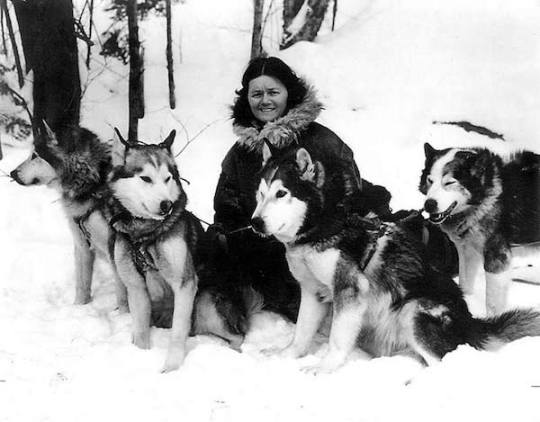
(Eva Seeley with four dogs from the first registered litter of Alaskan Malamutes including CH Gripp of Yukon. Parents were Yukon Jad and Bessie, a dog from Greenland).
The original Alaskan Malamute Standard has size as:
"Height: Of male dog averaging from 22 to 25 inches; of bitch averaging from 20 to 23 inches.
Weight: Of male dog averaging from 65 to 85 pounds; of bitch averaging from 50 to 70 pounds."
Prior to the M'Loot strain's inclusion into the breed registry the breeder of the strain, Paul Voelker lists his dogs as being: "mature dogs range from 23-26 inches at the shoulder and weigh 70-85 pounds".
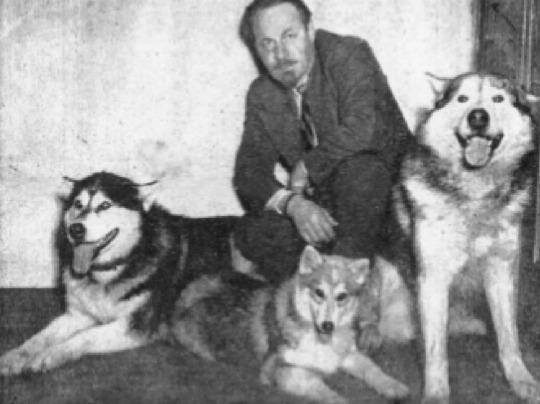
(Paul Voelker with three M'Loot dogs above).
We know that many M'Loot dogs were larger than this, often exceeding 100 pounds much like my own dog, Sigurd who is 30" at the shoulder at 105 pounds (despite his Kotzebue heavy pedigree...), so seeing 110 pounds near the top of the LEAN WORKING WEIGHT would be an excessive animal by anybody breeding this dog's standards, but certainly not unachievable. Again, not desirable to Eva Seeley (founder of the Kotzebue strain, nor to Paul Voelker, founder of the M'Loot strain).
Because of this middle ground where both strains liked dogs around 85 pounds and 25 inches at the shoulder the standard was revised in 1960 to accommodate the inclusion of these slightly larger dogs. The standard now states: "There is a natural range in size in the
breed. The desirable freighting sizes are: Males—25 inches at the shoulders—85 pounds. Females—23 inches at the shoulders—75
pounds."
Proportionally the dogs are longer than tall.
So while there are several different families of dogs that make up the founding of the breed there is only ONE Alaskan Malamute. There is no secondary "type" that is gigantic (120-140 pounds like people like to claim). There is not "standard" Alaskan Malamutes and "Giant" Alaskan Malamutes because 1.) the standard already allows for and encourages the natural size range in the breed which is quite varied. 2.) nobody breeding these dogs in the historical context was calling their strains "Giant Alaskan Malamutes".
So let's examine WHY people call their dogs "Giant Alaskan Malamutes".
The answer is simple: Marketing. People love giant dogs and often see them as status symbols (if you've ever been in a dog breed group where people are bragging about their dog's weight regardless of what shape that dog is in (often overweight) you know what I mean).
More nuanced is that freighting sled dogs like Malamutes, Qimmiq and Greenland Dogs look absolutely behemoth next to "normal" sled dogs like Alaskan Huskies (where 70 pounds is HUGE and 50 pounds is normal) or Siberians which are of a similar size to Alaskans). They're a large dog breed, but they're not giant in the range of actual giant breeds such as Irish Wolfhounds or Mastiffs etc.
Many people breeding "Giant" Alaskan Malamutes also falsely believe and/or tell their clients that their dogs are "pure M'Loot" and spout the mythology that true Alaskan Malamutes from Alaska way back in the day (which is a breed myth, they're not from Alaska remember) were HUGE. like 120-140 pounds huge and use this to justify the size of the dogs they breed (which are just backyard bred, oversized, sometimes not even oversized but just overweight individuals). This myth is easily proven false because it's not like the weight of Voelker's dogs are an unknown, we have heights and weights on many of them and they are very true to many modern "standard" Alaskan Malamutes today. One cannot even claim that the original indigenous dogs were massive because 1.) they didn't exist as explorers at the time often confirm in their writing that the indigenous dogs in Alaska were much the same as those being used across the arctic and into the east 2.) Inuit still use sled dogs today. Traditional Freighting Sled Dogs and we know what they look like and we know what their size is like. The myth that the Alaskan Malamute is some "lost dog breed" is false and takes agency away from Indigenous traditional mushers.
Additionally a huge majority of "Giant" Alaskan malamutes today can be broken down into two categories: those from North America and those from Asia.
"Giant" Alaskan Malamutes from North America will often come from very similar pedigrees. You will see a lot of Cascade, Wakon (particularly this kennel...claiming the dogs are 35" at the shoulders and nearly 200 pounds) and Kingfisher in these pedigrees. These dogs are often long haired, breeders within these lines will often breed long haired dogs purposely as many buyers want very fluffy dogs. Often the dogs are not any bigger than "standard" Alaskan Malamutes, but some can be very big (there is rumor of non-malamute giant breed admixture occurring in the 1980's). Most people breeding within these pedigrees are not necessarily doing the fullest extend of health testing, but it is thankfully becoming more common (can we please for the love of gods tho get people to test more than just hips please). Some dogs in this pedigree type are often accomplish weight pull dogs (because long miles are not being asked of them....) and may or may not be of showable quality, just from a breeder that prioritizes size and breed mythology bs over everything else:
They range from functional and pretty breed standard looking:

To what the fuck is this:
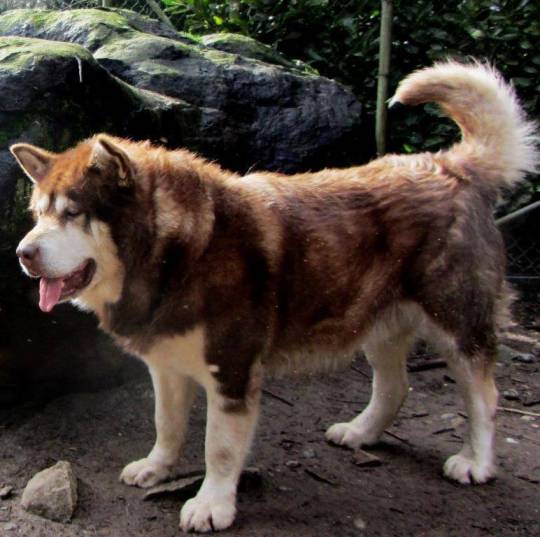
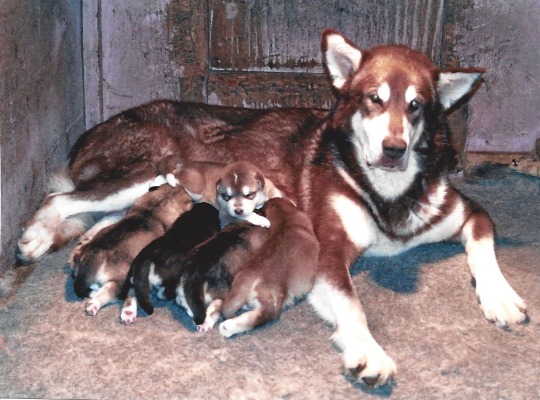
These above dogs are not a "type" of malamute, just dogs with similar pedigrees no different than any other. There are always going to be dogs within a breed that share close pedigree with each other, it's literally just part of how this works. They are not separate unless you want to talk about hush hush paper hanging.
"Giant" Alaskan Malamutes in Eastern Asia unfortunately bear the brunt of the breed's lack of ethics. These dogs are bred HUGE in size, overly loose, overly flewey and the breeders are not shy about the fact that they've bred Tibetan Mastiff into these dogs to achieve the size and hair level. These dogs are bred as pure status symbols and are not getting proper health testing done. I have never once seen a dog from these types of breeders do anything remotely functional. This is a dog that is bred for looks ONLY:
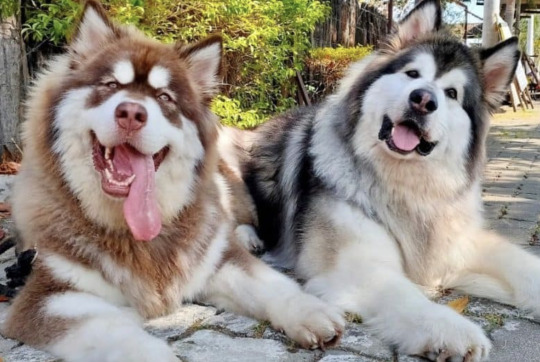
I'm sure you've all see this video (screen shot shown below) of a dog that is absolutely suffering:
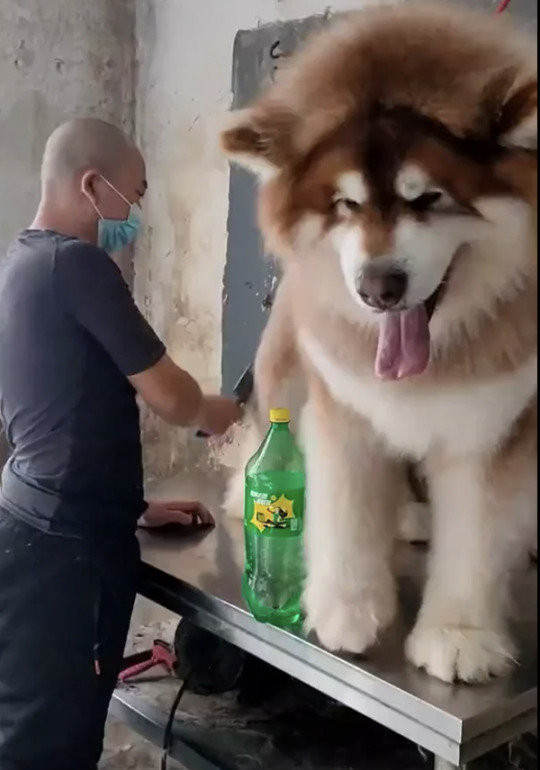
So when it comes to "Giant" Alaskan Malamutes there are some simple truths:
1.) They do not exist historically in Inuit freighting sled dogs
2.) Breeders in the mid-century, regardless of the strain of Malamute they preferred liked dogs around 85 pounds 25 inches at the shoulders.
3.) There are potentially hung papers within the breed histories of "Giant" dogs that may account for their overly large size.
4.) They are not a separate "sub-breed" or a different type of Malamute. They are simply all Alaskan Malamutes as the breed's standard allows for variation in size amongst the dogs.
5.) In my opinion breeding dogs overly large disrespects the purpose and function of the breed.
6.) Larger than average individuals can exist and often are produced from responsible breeders when breeding two ideal size or even smaller than ideal sized parents together. This is because genetics is complicated (Sigurd's mom was 80 pounds and his dad 25.5", 73 pounds. Sigurd is 30" and 105 pounds).
#dogblr#alaskan malamute#greenland dog#dog history#giant alaskan malamute#qimmiq#anyways because of the paper hanging and the NA 'giant' breeders distain for 'standard' dogs#it is unlikely that show/working breeders outside of their circles will associate with them#re: give them puppies or buy from them themselves#also lack of health testing until very recently#so i do suspect eventually they'll become a strain of their own#i can already kind of tell when a dog has certain kennels behind it bc i'm insane#but also even if they're recognizably pet bred 'giant' or whatever#they're still just alaskan malamutes#literally.
104 notes
·
View notes
Text
I commanded troops from both nations in Afghanistan, and Swedish forces in the Libyan campaign of 2011.[...]
One aspect of the Sweden-Finland accession gaining little geopolitical attention — when all is focused on Ukraine — is how they will add to NATO’s strength in the Arctic. When I visited the Nordic states a decade ago as the alliance’s supreme allied commander, their defense chiefs gave me a demonstration of their winter capabilities — their mastery at operating in what our Canadian allies call the High North, above the Arctic circle. I came away deeply impressed.[...]
Step back and look at the geography. The top of the world is a geopolitical Thunderdome, with the prize of the Arctic Ocean at the center. As global warming removes more and more of the ice cover, access to vital shipping routes and hydrocarbons — oil and gas — will be increasingly crucial for the nations on the front porch of the Arctic Sea. (My Bloomberg Opinion colleague Liam Denning, newly returned from the region, is doing an excellent series of articles and videos on all this.)[...]
The alliance should form a smaller “Arctic Coalition” within NATO to focus in increasing its defensive capability to the north.
14 Jul 23
15 notes
·
View notes
Text

BREAKING NEWS
SUPERMAN! MYSTERIOUS HERO SAVES THE WORLD
By Lois Lane, Senior Staff Writer
PUBLISHED: 23:00, 13th December 2013 | UPDATED: 23:46, 13th December 2013
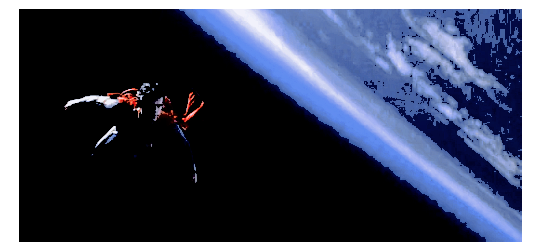
STRANGE VISITOR? Satellite footage taken from Wayne Enterprises.
An epic showdown over the skies of metropolis, the caped wonder we now call Superman, along with the United States Air Force, defeated a group of alien terrorists attempting to destroy the city and ultimately, the world.
Days ago General Zod and his Kryptonian army invaded global airspace, and declared the citizens of the Earth were harbouring a fugitive from the planet called Krypton. As government agencies scrambled to respond, clues about the alien living among us had already been discovered deep beneath a glacier in the Canadian Arctic Region, specifically Ellesmere Island. Embedded with the military and scientific teams of NORTHCOM, I witnessed their detection of a mass concealed in the ice. It was first believed that what they had found was Soviet era submarine, what they discovered was actually something much more exotic.
Interestingly, a series of UFO sightings occurred in the Manitoba region between 1975 and 1976. A mysterious signal began to emanate from beneath the ice of Ellesmere Island sometime in 2012, which was detected by a NASA satellite. The satellite then picked out an anomaly within the ice shelves. A mission to scope the icefield was commissioned in 2012 at the same site as Scout Ship 0344. Only, the Scout Ship was discovered a year later when I arrived.
An isotope analysis of the surrounding ice bores suggested that an object had been trapped in the glacier for over 18,000 years. The Pentagon was quick to deny any such encounter, but when the ship broke through its icy bounds and disappeared into the sky, questions were raised from locals in the area. Civilian contractors corroborated my recollection and their description of the ship matched my own. I had a firsthand experience in dealing with the alien visitor. He had secured a job working on the military base stationed just outside of Yellowknife, the capital, and the only city, and has the largest community in the Northwest Territories of Canada.
I followed the mystery man into the glacier, when I was scoping the area. He seemed to have known how the ship operated and activated it successfully. He rescued me when I was wounded from a Kryptonian robot, he possessed godlike strength and could shoot heat lasers from his eyes. My rescuer saved me from death, for which I am eternally grateful. I was unable to regain consciousness for a prolonged period of time and when I woke up, I was taken back to mainland Canada by military personnel with no answers from my questions posed by this appearance of an alien ship.
As for my rescuer? He disappeared during the object's departure. A background check revealed that his work history and identity had been falsified. The questions raised by my rescuer's existence were frightening to contemplate, but I also know what I saw I arrived at the inescapable conclusion that the object and its occupant did not originate on earth. Teams from across the world tried to track the ship, but were unable to locate its whereabouts.
MORE ON THIS DEVELOPING STORY IN TOMORROW'S EARLY EDITION... REPORTING ON THE PLANET, DAILY.
COMMENTS (2.26M) | LIKES (4.3M) | SHARES (9.56M)


5 notes
·
View notes
Note
learned a new whaling fact and immediately thought of telling you: whaling is still legal in some parts of japan, but the reasoning is that its traditional to some first nations of japan and the government doesnt wanna be like ‘hey guys whose land we stole and colonized…. uhhh stop your traditions too’
It is a whaling fact that I don’t believe is…exactly correct. People who have their thumb on the pulse of contemporary commercial & subsistence whaling more than I can jump in on this, too.
Currently the International Whaling Commission permits indigenous subsistence whaling as it connects to cultural importance and food sovereignty in four regions: Greenland, Chukotka, Bequia, and Alaska. Canada, to my knowledge isn’t part of the IWC, but also allocates specific quotas to subsistence whaling among indigenous groups in the Canadian Arctic. The Makah people in Washington state are also currently advocating for the ability to resume subsistence whaling too and it looks like that’ll come about soon (here’s a really good recent article on it). In my neck of the woods, when a dead whale washes up on a beach often due to vessel strikes, there have been members of the Shinnecock nation who perform a centuries-old ceremony called ‘podtap’ to honor the whale. But access to the whale beyond that is still restricted. Courtney Leonard, a Shinnecock artist spoke to this in an artist’s statement:
“Can a culture sustain itself when it no longer has access to the environment that fashions that culture?
Due to nation agreements with the United States government as well as New York State, topics of sovereignty, imposed law and environmental issues impacting our nation, The Shinnecock Nation of what is now referred to as Long Island, NY, has and continues to struggle with access to the material of the whales as they wash ashore having been often struck by the shipping boats that pass our waters.
Through the work of BREACH and by having the opportunity to travel to and connect with other indigenous water communities throughout the world, I have been able to research and learn about our common struggles and unique narratives as they pertain to 'access' and 'understanding'. "
In Alaska, the Inupiat hunt bowhead whales (again, within a quota) and also have a relationship with marine biologists tracking the bowhead population. Through that relationship biologists were able to receive an anatomical sample of one of the whales from the annual hunt (an eyeball), and by studying that sample to better understand the whales’ lifespan we now know that there are individual bowheads today who were alive during the height of the 19th century industry.
For the Inuit, they still aren’t able to hunt whales because the eastern bowhead (unlike the western), haven’t had as strong a population recovery/don’t have as much research to draw from. That same partnership with scientists is happening in the hopes that more information can be known about the population so the Inuit can ultimately resume their hunting rights. There’s a neat documentary about this here.
By law, indigenous people are still required to hunt whales the laborious ‘traditional’ way, rather than adopting new technologies that exist in the contemporary commercial whale fishery. And international environmental law is often slow to respond to what is best for those indigenous communities.
Japan (as well as Norway and Iceland) is largely involved in the commercial fishery today. But I think it’s important to note in relation to this ask that Japan was never colonized by Western imperial forces. Japan itself is a colonial power. And while there were small shore whaling fishing communities in Japan that existed prior to the ‘modern’ industry, it wasn’t until the latter half of the 19th century that Japan saw whaling as an expansion of that empire (modeled off the American imperial expansion that was also happening through whaling). There’s a good essay about this in the book Across Species and Cultures called Birth of A Pelagic Empire written by Jakobina Arch.
In our current day, Japan for a time used loopholes in the IWC that permitted killing whales for ‘scientific research’, and it pulled out of the Commission in 2019. Only a few hundred people are employed by the whaling industry in Japan today, and Norway (which also objected to the IWC quotas) still kills the most whales out of the three countries, but currently isn’t meeting its own internal quotas. Iceland states it’ll be pulling out of the industry by 2024. There are also international restrictions on what whale species are hunted, linking back to the population devastation that started in the 19th century and became even more ruinous in the 20th century as technology grew. Contemporary commercial whaling is a water I don’t particularly like to wade into, but ultimately it seems that regardless of what arguments are happening around it, commercial consumption of whale meat is on the decline in all of these places and thus it makes sense that commercial whaling will soon follow suit.
35 notes
·
View notes
Photo

It takes time: One difference between sea ice and freshwater ice is that sea ice takes much longer to form. This image is from Franklin Strait in the Canadian Arctic. In polar regions, sea ice differs from icebergs and glaciers, which are formed by freshwater and snow.
PHOTOGRAPH BY @DAISYGILARDINI
#@daisygilardini#photographer#sea ice#freshwater ice#franklin strait#canadian arctic#landscape#nature#polar#icebergs#glaciers#national geographic
79 notes
·
View notes
Text
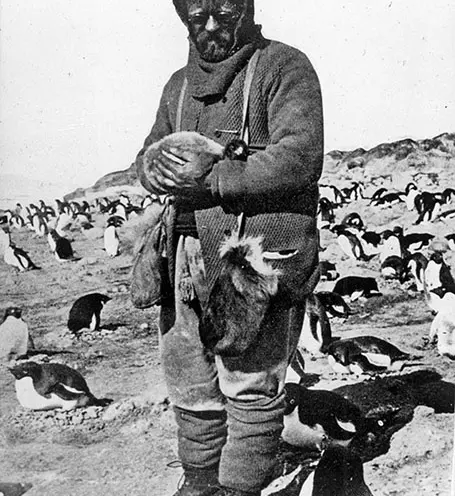

The Biologist and explorer James Murray was born in Glasgow, on July 21st 1865.
Murray began the study of medicine, but gave that up to study sculpture at the Glasgow School of Art. After travelling in the United States and Europe, he returned to Glasgow and became a member of the Natural History Society of Glasgow, publishing papers on flora and fauna.
In 1902, Murray was appointed biologist on the Scottish Loch Survey, while engaged in this work, he was selected as biologist and naturalist on the British Antarctic Expedition, 1907-1909 led by Ernest Henry Shackleton) During the absence of the two parties attempting to reach the South Magnetic and Geographical Poles, Murray was placed in charge of the winter quarters, Cape Royds, and spent much of his time examining the flora and fauna of the surrounding district.
On his return from the Antarctic, Murray joined the Bolivian Boundary Commission as naturalist, publishing notes on his scientific work in the region. He joined the Canadian Arctic Expedition, 1913-1918 led by Vilhjalmur Stefansson, as oceanographer in Karluk. The ship was originally attached to the Northern Division of this expedition, and assigned the role of establishing a base for Stefansson and the scientists on the north-western fringe of the Canadian Arctic archipelago. However, after transporting Stefansson to Alaska, Karluk became beset in the ice and sank. Led by Captain Bob Bartlett, a camp was established on the ice at the site of the wreck. In February 1914, Murray, with three companions, left in an attempt to reach land, and was last seen approaching Herald Island.
Any film buffs out there might remember the Scottish character in The Lost City of Z played by Angus Macfadyen, well he played Murray in the film, although he wasn’t painted in a great light we have to remember it was Holywood, just like another film Angus starred in……now what was that called again….
There’s an article about the Shackleton expedition on the link here https://oceanwide-expeditions.com/.../the-disastrous...
10 notes
·
View notes
Text



Seeing a bunch of Americans laugh at the idea of Canadian wine is really funny to me. The Niagara peninsula is one of the biggest wine growing regions in the world, and it's pretty good stuff these days, and not just the icewine. I'd put it ahead of anything I've had from California in most cases. Canadian beer is pretty damn good too, so is our whiskey, and I've had some really nice Canadian gin distilled up in Nunavut using arctic flowers to flavour it.
Of course the only reason this exists is that there are crown corporations with quasi monopolies on alcohol sales in every province and there are prohibitively high taxes on foreign imports. It's the only real reason that domestic alcohol production for domestic consumption is economically feasible. I don't think you can even buy the better Canadian domestic/large microbrew beers in the States, let alone the good microbrew stuff. Like can you guys get the halfway decent domestics like Moosehead, Sleeman's Cream Ale, or Steamwhistle? I know you can get the real shitty domestic stuff like Labatt's and Molson, but I honestly don't know what's available south of the border. The last time I was in the States it was 2008/09 and I can't remember what we were drinking, probably Pabst Blue Ribbon or something.
#blog#personal history#man i wish i could still have a drink now and then without it making me feel awful for the next three days#i had one beer on thanksgiving and it instantly made me crash and miss dinner#i used to love a gin and tonic#so I've basically only had one beer in the last three years
5 notes
·
View notes
Text
summary of ned land's introduction in 20k leagues:
aronnax: oh ned. my valiant canadian who i cherish and adore so much. you are so tall and strong and brave you are like a "canadian homer reciting his iliad of the high arctic regions."* i love you so much. "ah, my gallant ned! i ask only to live 100 years more, the longer to remember you!"**
ned: i think a squid caused the shipwrecks.
aronnax: that's stupid. here's a ted talk i prepared about how stupid that idea is. first off, squids are squishy...
*actual line from the book
**another actual line from the book
6 notes
·
View notes